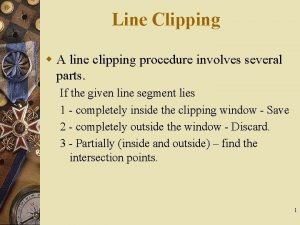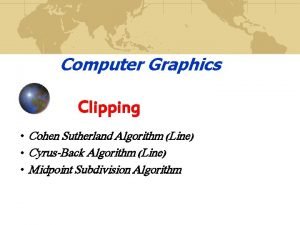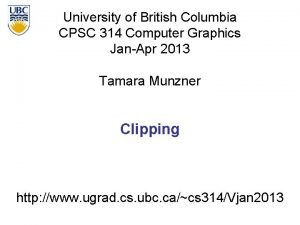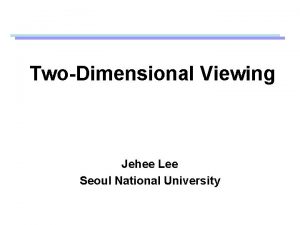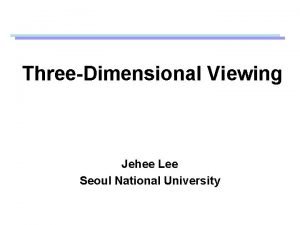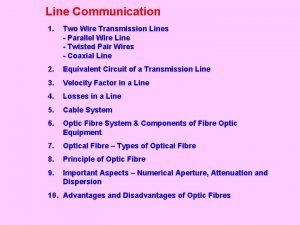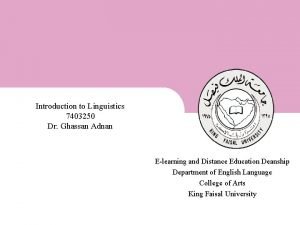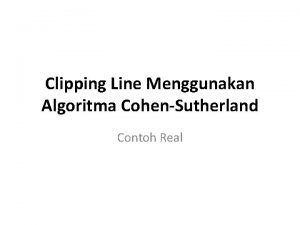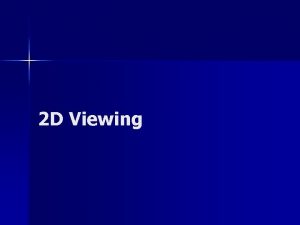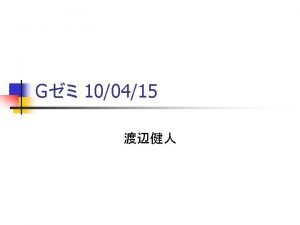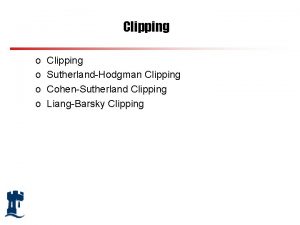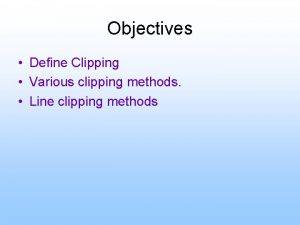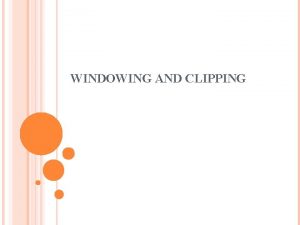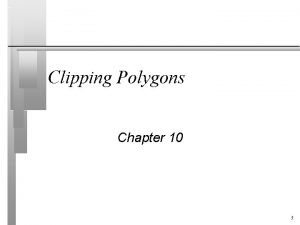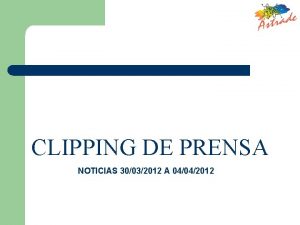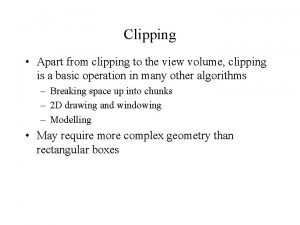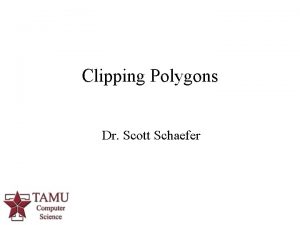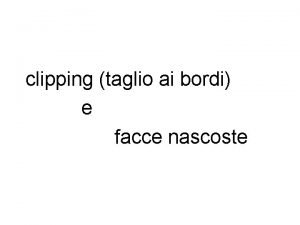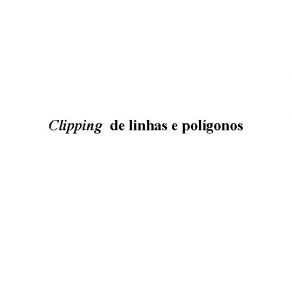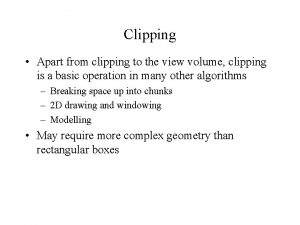Line Clipping w A line clipping procedure involves





















- Slides: 21

Line Clipping w A line clipping procedure involves several parts. If the given line segment lies 1 - completely inside the clipping window - Save 2 - completely outside the window - Discard. 3 - Partially (inside and outside) – find the intersection points. 1

The Cases w Case 1: both endpoints of line segment inside all four lines – Draw (accept) line segment as is y = ymax x = xmin x = xmax y = ymin w Case 2: both endpoints outside all lines and on same side of a line – Discard (reject) the line segment 2

The Cases w Case 3: One endpoint inside, one outside – Must do at least one intersection w Case 4: Both outside – May have part inside – Must do at least one intersection y = ymax x = xmin x = xmax 3

Line Clipping w Possible relationships between line positions and a standard rectangular clipping region 2 1 3 3 Before clipping after clipping 4

Line Clipping w Parametric representation of a line x = x 1 + u(x 2 - x 1) y = y 1 + u(y 2 - y 1) w The value of u for an intersection with a rectangle boundary edge – Outside the range 0 to 1 – line does not enter the interior of the window. – Within the range from 0 to 1 – cross the clipping area. 5

Line Clipping w 3 line clipping algorithms : w 1. Cohen-Sutherland Line Clipping w 2. Liang – Barsky line Clipping w 3. Nicholl-Lee-Nicholl Line clipping 6

Cohen-Sutherland Line Clipping w Region code – A four-digit binary code assigned to every line endpoint in a picture. BIT 4 BIT 3 BIT 2 BIT 1 4 3 2 above below right 1 left Region Code Legend 7

Cohen-Sutherland Line Clipping w Check for visibility of line P 1 P 2 - If region codes for both endpoints P 1 and P 2 are zero then the line is completely visible. Hence draw the line. - If region codes for endpoints are not zero and the logical Anding of them is also nonzero then the line is completely invisible, so reject the line. - If region codes for two end point do not satisfy the above conditions the line is 8 partially visible.

Cohen-Sutherland Line Clipping w The possible relationships: • Completely contained within the window • 0000 for both endpoints. • Completely outside the window • Logical and the region codes of both endpoints, its result is not 0000. • Partially 9

Cohen-Sutherland Line Clipping w Intersection points for a line with endpoint coordinates (x 1, y 1) and (x 2, y 2) is given as y =y 1 +m (x-x 1) w slope of line is calculated as m = (y 2 - y 1) / (x 2 - x 1) w the intersection of the x coordinate can be calculated as x= x 1 +( y- y 1) / m 10

Liang-Barsky Line Clipping w Consider the parametric definition of a line: x = x 1 + u∆x y = y 1 + u∆y ∆x = (x 2 - x 1), ∆y = (y 2 - y 1),

Liang-Barsky Line Clipping w The parameters p & q are defined as w p 1 = -∆x w p 2 = ∆x w P 3= -∆y w P 4= ∆y q 1= x 1 - xwmin q 2= xwmax - x 1 q 3= y 1 - ywmin q 4= ywmax - y 1

Liang-Barsky Line Clipping w Cases: 1. pk = 0 • Line is parallel to boundaries – If for the same k, qk < 0, reject – Else, accept 2. pk < 0 • Line starts outside this boundary • rk = qk / pk • u 1 = max(0, rk, u 1)

Liang-Barsky Line Clipping w Cases: 3. pk > 0 • Line starts outside this boundary • rk = qk / pk • u 2 = min(1, rk, u 2) 4. If u 1 > u 2, the line is completely outside and it can be rejected.

Liang-Barsky Line Clipping 5. If u 1 < u 2, calculate the end points as x x 1 = x 1 + u 1 ∆x y y 1 = y 1 + u 1 ∆y And x x 2 = x 1 + u 2 ∆x y y 2 = y 1 + u 2 ∆y

Nicholl-Lee-Nicholl Line Clipping 16

Nicholl-Lee-Nicholl Line Clipping Partition the region based on the first point (p 1): – Case 1: p 1 inside region – Case 2: p 1 across edge – Case 3: p 1 across corner

Nicholl-Lee-Nicholl Line Clipping Case 1 Case 2 T LT L p 1 R L L LR LB B p 1 Case 3 L T LB T TB TR 18

Nicholl-Lee-Nicholl Line Clipping 19

Nicholl-Lee-Nicholl Line Clipping 20

Nicholl-Lee-Nicholl Line Clipping 21
 Nicholl lee nicholl line clipping
Nicholl lee nicholl line clipping Cohen sutherland line clipping algorithm with example
Cohen sutherland line clipping algorithm with example Line clipping
Line clipping Line clipping
Line clipping Line clipping
Line clipping Cohen sutherland line clipping algorithm solved example
Cohen sutherland line clipping algorithm solved example The major product line decision involves
The major product line decision involves Two wire line communication involves
Two wire line communication involves Eg subject code
Eg subject code First line break procedure
First line break procedure Procedure of pure line selection
Procedure of pure line selection Exterior clipping
Exterior clipping Back formation
Back formation Coinage in morphology
Coinage in morphology Back formation in morphology
Back formation in morphology Ppt
Ppt Sutherland hodgman algorithm in computer graphics
Sutherland hodgman algorithm in computer graphics Algoritma cohen sutherland
Algoritma cohen sutherland Tidak
Tidak Ywmin
Ywmin Recap intensity clipping
Recap intensity clipping Bezier clipping
Bezier clipping
